Colors

Pug Dog Colors
Overview
Pugs can be found in four major colors, though not all are standard colors with certain kennel clubs. The two most common colors are fawn and black. Silver and apricot can also be seen with this breed, and while not standard colors per the AKC, these colors are indeed recognized by the FCI and other kennel clubs. Brindle Pugs do exist, though this is not without some controversy.
All non-black Pugs have black masks and black ears.
There are some unique color markings that can appear on Pugs which include the trace and the thumbprint, found only on non-black Pugs.
This section will cover all of the details regarding Pug colors, both standard and alternate, as well as various markings and other color-related elements.
Breed Standard Colors for Major Kennel Clubs
The AKC (American Kennel Club) recognizes only two colors for Pugs in the show ring: fawn (S 082) and black (S 007).
But, of course, since other colors exist, an AKC Pug can be silver (also known as silver-fawn), apricot (also known as apricot-fawn), or even the rare and controversial brindle.
If you have a Pug with a non-standard color (silver-fawn, apricot, or even brindle), as of the time of this writing, if you register your Pug via postal mail (not online) and send in photos of your Pug that clearly shows the non-standard coat, the AKC will usually grant you a registration with the appropriate color or pattern listed as an alternate color.
Though a Pug of any color can be registered, this does not mean the color is accepted in the show ring. For AKC conformation events, any color other than fawn or black is a disqualification. It should be noted that the AKC, which follows the guidelines set forth by the Pug Dog Club of America, used to accept both silver and apricot-fawn.
The FCI (Federation Cynologique Internationale) and KC (The Kennel Club of the UK) allows for 4 colors for the Pug: Silver, apricot, fawn, and black.
The CKC
(Canadian Kennel Club)
allows for 3 colors: fawn, silver-fawn and black, though this technically means even more colors, since ‘fawn’ for a CKC Pug can mean any shade including light apricot and deep apricot to reddish gold.
The Most Common Pug Color
Brutus (fawn) and ZsaZsa (black)


photo courtesy of Kristina Olson
You may be wondering if there are more fawn Pugs or more black Pugs. The answer is that about 2/3 of Pugs are fawn or in the fawn range.
Our survey of 2,693 Pug dog owners (the full results of the survey can be found in PetPugDog's GIANT Book of Pug Care) asked the question of ‘What color is your Pug?’. If you are in the US, where most Pugs are either fawn or black, keep in mind that owners from 27 countries took part in the survey. The majority of owners, 54%, were in the United States; however, 18% were in the UK, 7% were in Canada, 6% were in Australia, and the remaining 15% were from other countries including India, Indonesia, South Africa, Mexico, the Netherlands, and New Zealand, to name a few.
The results showed that the majority of Pugs, 65%, are fawn. Black was the second most common color, at 22%. A small number, 4%, were apricot, 3% were silver-fawn, and 1% were brindle. 1% of owners answered ‘I’m not sure’, and 3% answered ‘Other’. Comments left under the ‘other’ option included ‘black with a white marking’, ‘black with tan markings’, ‘fawn with black/silver on the tips’, and ‘fawn with black legs’.
Types of Fawn
Overview:
With AKC having just two colors for the Pug, fawn is a very broad-reaching hue. Other well-recognized kennel clubs such as the FCI and KC make this much easier, since they accept apricot and silver coat colors in the show ring. And, the CKC allows distinction between fawn and sliver, by having 'silver-fawn' as an option. With these clubs, fawn is a light to medium cream.
However, because the AKC will register a fawn as a fawn and
an apricot or a silver as a fawn (because they are non-black Pugs), but
can also grant a registration for an apricot or silver to be as such via an alternate color, an AKC fawn Pug may truly be a fawn (ranging from light cream to medium cream) or technically be a silver or apricot (more ahead on these colors).
All non-black Pugs, including fawn, have black ears and black masks (more ahead on this).
Variances:
Fawns are not always solid, there are variances in the coat. Many Pugs have a trace which is a stripe of back-tipped hairs running down the back that break up the fawn color. And, it is not uncommon for two shades of fawn to be seen within one coat; for example, a light cream fawn can blend into a light apricot-fawn. The wrinkles on a Pug are also responsible for color variances since a thumbprint may be present which is black fur in the creases and folds of the forehead.
AKC Color Disqualification:
Though fawn has a range of light to medium, the AKC does make it clear that anything other than fawn or black is a disqualification in the show ring. This refers to not only what the registration papers say but by what color is seen in person during the competition. Since there is sometimes a blurred line between silver and fawn or apricot and fawn, this can make things tricky. These colors are found all throughout the world, but in the US, show breeders focus on keeping the fawn a fawn without silver or apricot tones.
Examples of Fawn Pugs:
Dubi at 6 years old, a fawn Pug
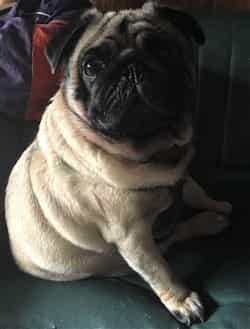
photo courtesy of Carmina Bautista
Poppy, at 4 months old, a Pug with a combination of light and medium fawns
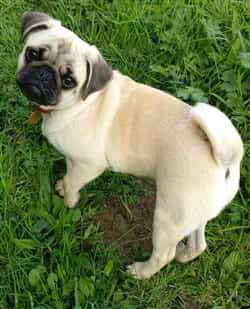
photo courtesy of Maria
Silver Fawn and Silver
Overview:
This is a color that is not overly common with Pugs; though, many owners of silver or silver fawn Pugs can easily be labeling their dogs as fawn, especially if that is what the registration papers state. Because, as the name implies, silver fawn is a type of fawn. It is very light and is in fact the lightest color that a Pug can be. As touched on earlier under 'The Most Common Pug Color', in our survey of 2,693 Pug owners, only 3% identified their Pugs as silver-fawn or silver.
The AKC does not recognize this as a standard color, but may grant a request for a silver-fawn Pug to be registered as such via an alternate color, and if so, generally only responds to requests that are sent via postal mail. Both the FCI and KC allow for silver and the CKC allows for silver-fawn; both are essentially the same coat color but are referred to with these different terms.
Silver or silver-fawn Pugs have black ears and black masks and may also have a trace and/or a thumbprint, both of which are markings very desired in the show ring by all major kennel clubs.
Example of a Silver Fawn Pug:
Puggie, a silver-fawn Pug
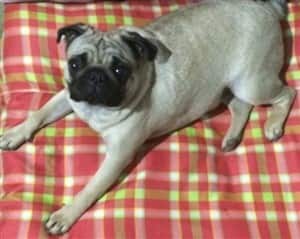
photo courtesy of Berdie Menezes
Apricot Fawn and Apricot
Overview:
Apricot is a warm undertone of orange. With some other breeds, this sort of orange hue is referred to as fawn (like with Boxers) or as orange (like with Pomeranians). But, with Pugs, this is a nice, shiny orange hue that is set apart from the more common fawn coat.
It is very common for apricot Pugs to not be fully apricot; there may be some fawn or even an almost white color found in patches, most often on the chest.
This is a color that is not seen too often; as mentioned earlier in 'The Most Common Pug Color', out of 2,693 Pugs, only 4% identified their Pugs as being apricot or apricot-fawn. Though, just like silver or silver fawn, this is also a color that may be present in the coat, but owners refer to their Pugs as simply 'fawn', especially if that is what the registration papers deem the Pug to be.
And, just like other non-standard AKC colors, an apricot Pug may be registered as a fawn or as an apricot if the owner requests for this alternate coloring to appear on the document. Both the FCI and KC do allow apricot as a standard color. With the CKC, apricot is not its own color, but rather their definition of fawn includes all shades in the fawn family including light to deep apricot.
Apricot Pugs have black masks and black ears. And, just like all non-black Pugs, a trace and a thumbprint are desired in the show ring of all well-recognized kennel clubs.
Example of an Apricot Pug:
Peggie, at 4 years old, a registered apricot Pug
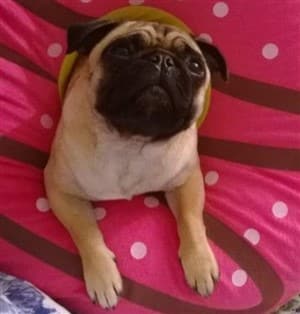
photo courtesy of Susi R Ludlow
Black Pugs
Overview:
It is rather amazing how very different the two main colors of Pugs are; fawn is a very light cream with black ears and mask, and black Pugs are just about the complete opposite with a rich, dark black coat. Of course, the ears and mask are black too, but there is no discernible difference since the entire Pug is black.
Many black Pugs have solid coats, but it is possible for there to be a small white marking; if this is present, it is usually on the chest. As Pugs age into their senior years, gray hairs may appear on the face or in different areas of the body and this is much more noticeable with black Pugs.
Black Pugs are seen less often than fawns; as mentioned in 'The Most Common Pug Color', in our survey of 2,693 owners, just 22% identified their Pug as having a black coat (593 of the puppies and dogs).
Examples of Black Pugs:
Henry, at 10 months old
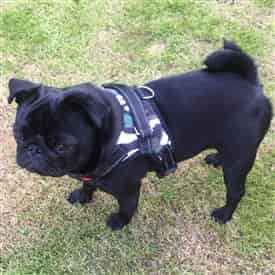
photo courtesy of Maxine Aird
Pearl
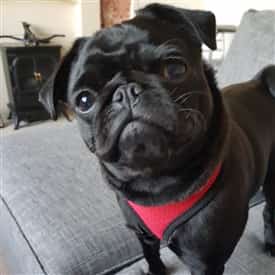
photo courtesy of Saz Race
Wonder how much exercise Pugs need and how to keep activity safe for this brachycephalic breed?
Check out Pug Dog Exercise.
Brindle Pugs
Overview:
Brindle is a pattern of interlocking light and dark colors which creates a striping effect. With Pugs, this is typically in the grey to black range. This type of coat pattern is found with quite a few other dog breeds including the Bull Terrier, Boxer, and American Bulldog.
This is not an accepted Pug coat color with any of the well-recognized kennel clubs and is a disqualification in show with the AKC, CKC, KC, FCI, and others.
This said, as mentioned earlier under 'The Most Common Pug Color', in our survey of 2,693 owners, 1% identified their Pug as being brindle.
The Debate:
Many wonder if a purebred brindle Pug can even exist. The answer is yes. This said, there are some explanations to be given.
On one hand is the argument that brindle does not exist within the Pug's bloodline. It is true that this is not a color pattern that should be seen with today's breeding programs since it is not a standard color. One of the goals of reputable breeders is to produce dogs that come as close to breed standards as possible. So, brindle is not something that most breeders would strive for and any champion dogs would not have recessive brindle genes.
But, did brindle appear in the bloodline at some point in the past? The answer is, yes, it very well could have. This goes back, in part, to the fact that every single dog breed that exists to day was developed from the pairing of other breeds. As to which breeds, exactly, were used to develop the Pug is unknown.
We know that this breed was developed in China. Somewhere around 200-225 B.C. all records concerning Pugs were destroyed by the Emperor Chin Shih Huang to hide the 'secrets' of this breed. And he was indeed successful. Therefore, the first element to note is that no one can say if, looking back, brindle is or is not found in the Pug's bloodline. In fact, paintings from the 1700's show Pug dogs with brindle coats. This said, those brindle lines most likely died out.
It has also been debated that brindle Pugs are a myth since the gene responsible for the pattern is dominant and would 'take over' the entire Pug breed with eventually only brindles existing, making fawns and black obsolete. But, that point is not accurate. Brindle exists in other breeds and does not take over. One example is the Boxer dog in which there are both brindles and fawns.
So, if there are brindle Pugs, however rare, where does the brindle come from?
The answer is that brindle was introduced into the bloodline via another breed at some point. For each individual Pug, this could be recent or it could be many generations in the past. Yet, there are owners with brindle Pugs that have had DNA testing done on their dogs and the results came back as ‘purebred Pug’.
This may seem contradictory. The key is to keep in mind the term ‘at some point’. A brindle Pug may have another breed (most often a Boston Terrier or French Bulldog) 10 or even 20+ generations back. As time goes by, a random brindle is thrown every now and then. The brindle Pug may be 99% Pug with DNA from other bloodlines nearly removed.
Examples of Brindle Pugs:
Luna at 8 months old, a brindle Pug

photo courtesy of Brenda
Gabby, another brindle Pug

photo courtesy of Mike Dillow
Color Changes
It is normal for a Pug puppy's coat to change coat color (to a certain degree) as he or she is maturing from pup to adolescent.
With fawn Pugs, the coat may lighten or darken, predominately during the first year. It's not uncommon for there to be smuttiness at a young age which is the term for black hairs intermingled with a light color coat. This may remain, lighten, darken, or fade in other areas except for a line running down the center of the back which is known as a trace. The ears and mask may darken into a more solid black as a Pug grows.
For example, here we see Yoda as a young puppy (first photo below on mobile) with a fawn base and lots of black hairs running through the coat (referred to as smuttiness - details ahead). And, then we can see Yoda as a 3-year-old adult Pug (second photo below on mobile), the fawn is much lighter and the black-tipped hairs are now a much more faded trace that runs down her back. The black mask has darkened and her head wrinkles are fully developed.
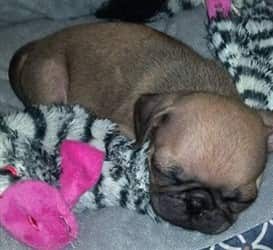

There can be other color changes as well. Apricot tones may not appear until a Pug is a bit older; so, a Pug that is registered as a fawn may very well be an apricot.
Another change that typically happens with black Pugs, but may also be seen on some fawns, is that hairs around the muzzle and face may gray as a Pug transitions into the senior years. If this occurs, it is generally starts around the 8 year mark and increases in time.
Wondering how much sleep a Pug needs and ways to help this breed achieve a good night's rest?
Check out Pug Dog Sleep.
Smuttiness
If you take a very closeup look at a light-colored Pug, you may see a scattering of a few black hairs over the body and this is generally not enough to classified a Pug has having smuttiness.
Smuttiness on a Pug refers to a noticeable overlay of black hairs on a light coat (fawn, silver, silver-fawn, apricot, or apricot-fawn). These patches of black hairs are thin enough to see the lighter hairs underneath, however it gives an overall appearance of a "haze". The more there is, either in density or coverage, the more smuttiness a Pug has.
Note that black (or darker hairs) are desired in certain places on a Pug; running down the center of the back (the trace) and on the forehead (the thumbprint - more ahead on both of these markings). But, when there is an overabundance of these black hairs in areas other than the forehead wrinkles or the back, the term smuttiness is then used.
Smuttiness may appear in just about any area on a Pug including the saddle (back), flanks, legs, and head. In the show world, this is not a disqualification, however it is considered to be a fault (points are deducted).
Example of Smuttiness on a Pug:
Winston at 11 years old; this is an example of heavy smuttiness on the head. Though not something rewarded for in the show ring, there is no denying how cute this Pug looks. In fact, this is such a heavy intermingling of black hairs that Winston almost looks like a half fawn and half black Pug dog.
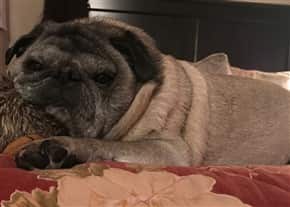
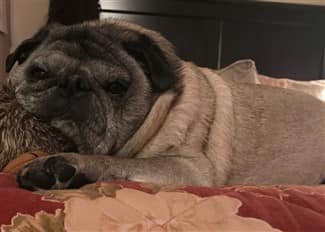
photo courtesy of Shane
The Trace
This term refers to a line of darker color that runs down the back and of course is only seen on non-black Pugs.
The trace may begin on the nape of the neck or further down the back. It will run in a predominantly straight line, ending at the base of the tail. The thickness and the density of the trace can vary.
Though a trace is a very desired trait in conformation dog shows, not all non-black Pugs have this marking. In our comprehensive survey of Pug owners (the full results appear in PetPugDog's GIANT Book of Pug Care), when asking only the owners of non-black Pugs, 'Does your Pug have a trace', 77% answered 'yes'.
A trace may be very apparent during the puppy years and then fade as a Pug matures. On the flip side, this marking may not show at all during the newborn phase and then become apparent as the Pug grows. This particular element is considered to be an official marking of the breed and is thought to give Pugs character. In the show ring, the blacker the trace, the better. That said, if your Pug does not have a trace, this is nothing to be concerned about. If, however, when Pugs are being considered for a breeding program with the goal of producing show quality dogs, those with no trace at all are often excluded since this is a heredity trait.
Example of a Trace on a Pug:
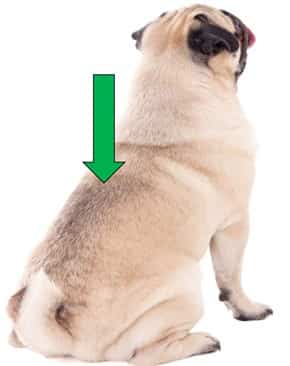
Do you have a Pug and are worried about leaving them home alone?
Find helpful tips for Pug Dog Separation Anxiety.
The Thumbprint
A Pug's thumbprint, also referred to as a thumb mark or diamond, is a darkened spot centered on the forehead. This, of course, is not seen on Pugs with black coats.
Though this is another desired trait when Pugs are judged in conformation events, not all non-black Pugs have a thumbprint. When polling owners of non-black Pugs, 77% reported a thumbprint on their Pug, which means 23% did not have this marking. Another way to look at this is that approximately 3 out of 4 non-black Pugs have a thumbprint or thumb mark.
Though it is sometimes called a diamond, it may resemble an oval, a circle, or be an irregular shape. While the wrinkles
on the forehead can cause shading that may appear to be a thumb mark, the thumb mark is actually a splash of darker color on the fur.
This type of marking is usually present at birth. It is rare for a Pug born without this to develop one as he ages. When a young pup has a small thumbprint marking, it may grow larger or become darker as a Pug ages and matures.
Example of a Thumbprint on a Pug:
This is Tommy, a Pug with a nice thumbprint on his deep forehead wrinkles.
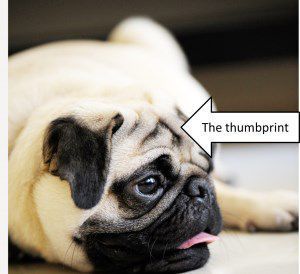
photo courtesy of Srinivas, Dubai, UAE
The Mask
All non-black Pug dogs have masks and this is a very defining feature of this breed for those with fawn, silver-fawn, or apricot-fawn coats. This is an area of black that typically starts under the chin, covers the muzzle, and extends around the eyes. Though this is the general description, the mask can vary quite a bit on Pugs.
One element to take note of is that the black may be mainly on the muzzle and then again with black fur around the eyes with little connection between the two points or, quite contrary to that, black may extend from the muzzle to the eye area with no interruption at all.
In addition, while a very dark black mask is desired in the conformation show ring, the black mask on some Pugs may contain any number of fawn or lighter-colored hairs.
Examples of Black Masks on Pugs:
Percy, at 5 years old, has a mask that is not quite fully black, there is an intermingling of some fawn hairs
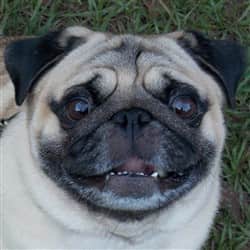
photo courtesy of Hope Harman-Potteiger
Milo, 6, has a black mask on the muzzle & black is tight around the eyes, but without a significant amount of black connecting the 2 areas

photo courtesy of The Warner Family
Peppa Pig, at 6 years old, has a very deep dark black mask over her muzzle and extending up and around her eyes with no interruption at all.

photo courtesy of The Montes Family
Eye Color
All purebred Pugs have brown eyes. This can range from medium to dark brown and eyes can be so dark that they almost appear black.
Coat color does not affect eye color; for example, a fawn Pug does not automatically have lighter eyes than a black Pug.
You may be curious to know if Pugs can have blue eyes. Blue is not in this breed's genetic code. However, similar to humans, dogs are usually born with dark blue eyes (due to low levels of melanin in the eyes). The eyes darken as melanin levels naturally increase. This transition is usually complete by week six or seven.
White Paws
Can a Pug have mitted, white paws? The term 'mitted' is often used with cats since it is much more common for felines to have this type of color marking. It refers to coloring that falls on the paws that is different than the main body color, as if the animal is wearing mittens.
White paws on a Pug is not common at all and is considered a major fault in the show ring; however, it can happen. This Pug (below) has a fawn coat and white markings on the paws and on the chest.


Both photos are of Mr. Mittens, at 3 months old; photos courtesy of Suzanne
White markings like this are able to exist due to the parti-factor gene. This very same color gene is responsible for small white markings on the chest that are occasionally seen with Pugs of all colors. Rarely, the parti-factor is thrown to one, some, or all paws, resulting in purebred Pugs with white mitted paws.
Are you taking care of your Pug's teeth?
For this brachycephalic breed, dental care is very important. Learn how to keep your Pug's teeth clean and healthy.
Behavior and Personality Traits Based on Color
Many people wonder if there are inbred character traits that vary depending on the coat color of the Pug. As with any other breed, the coloring of the coat has no effect on energy level, personality,
behavioral quirks or any other element.
But, it is easy to leap to the belief that color matters in this regard. An owner may have a black Pug that is more energetic than his fawn counterpart, for example. However, there are just as many owners who have energetic fawns compared to laid back black Pugs. Each dog is an individual, and Pugs will have their own unique personalities, regardless of coat color.
Differences in Coat and Shedding
Most Pugs have coats consisting of two layers of fur, an inner and an outer coat. Some, but not all black Pugs are single coated. For this reason, a percentage of black coated Pugs may shed less in comparison to fawn, apricots or slivers.
And, the color of your carpeting and furniture can affect how much shedding you notice. Fur that sheds from a black Pug onto light-colored surfaces is going to be much more noticeable than fur that falls from a fawn Pug. And, fur that sheds from a fawn Pug onto dark surfaces is going to be much more visible than fur that falls from a black Pug. Though it's not suggested to buy furniture and flooring that matches your Pug, this is something to keep in mind.
Did you find this to be informative?
If so, you are absolutely going to love our book, PetPugDog's GIANT Book of Pug Care. See what's inside.
Related:
Black Pug Dogs
- More photos of black Pug puppies and dogs with a recap of color information.
PetPugDog.com Copyright 2019. All rights reserved. Privacy Policy
We are a participant in the Amazon Services LLC Associates Program, an affiliate advertising program designed to provide a means for us to earn fees by linking to Amazon.com and affiliated sites.
